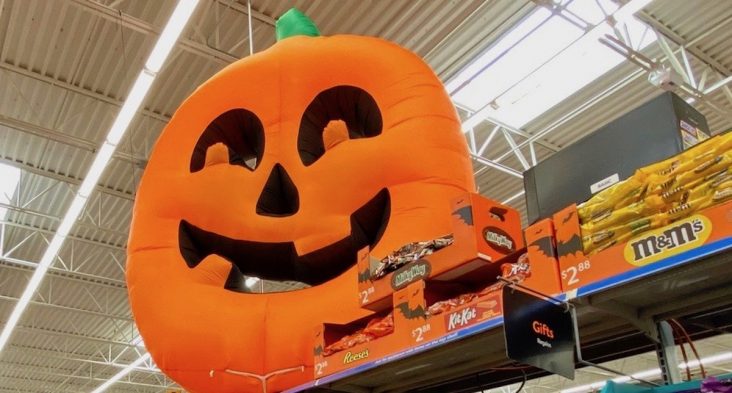Consumers expected to spend $10.6 billion for Halloween
by September 20, 2022 2:00 pm 5,798 views

Consumers are ready to celebrate big this Halloween after two years of reduced participation because of COVID-19. The National Retail Federation, working with Prosper Insights & Analytics, reports that 69% of Americans plan to celebrate the holiday, up from 65% in 2021 and 58% in 2020.
Total Halloween spending is expected to reach a record $10.6 billion, exceeding last year’s $10.1 billion, and the participation rate is even better than the pre-pandemic year of 2019 at 68%. NRF said consumers plan to spend an average of $100 this year on candy, decorations, cards and costumes. The amount is on par with last year’s average of $103.
“Halloween is an exciting time for many families, and that enthusiasm is reflected in the number of Americans who plan to celebrate the holiday this year,” NRF President and CEO Matthew Shay said. “As consumers continue to return to pre-pandemic behaviors, retailers are prepared to meet that demand and help make this holiday a fun and memorable one.”
The most significant part of this year’s spending will be on costumes as trick or treating and fall festivals are expected to resume pre-pandemic levels. Adults are expected to spend $1.7 billion on their costumes and another $1.2 billion on kids’ costumes, with a whopping $710 million on pet costumes. Total costume spending is expected to top $3.6 billion, up from $3.3 billion last year and $3.2 billion in 2019 before the pandemic.
Spiderman is the most popular costume for children, with more than 2.2 million children planning to purchase that costume. The princess costumes are popular with 1.9 million kids this year, while the classic witch and ghost will be the costume of choice for 1.6 million and 1.3 million consumers. Other popular costumes for kids include pirates, vampires, zombies, Batman and Superman.
Adults who plan to purchase costumes said they are most likely to be witches (5.3 million). A vampire was the second choice by 1.7 million, and 1.5 million adults plan to dress like a ghost. Catwoman, Batman, Dracula and Spiderman were popular choices with adults.
NRF said 67% of consumers said they plan to hand out candy to trick-or-treaters. The survey found that 47% dress up in costume, and 44% say they plan to carve a pumpkin. About one-third said they plan to attend a Halloween party, and 20% said they would dress up their pet in costume. More than half said they are decorating their home or yard and purchasing some new decorations.
Similar to recent years, Halloween enthusiasts will once again start their shopping early, with 47% beginning in September or earlier. Also, 40% plan to purchase their items at discount stores, 36% will go to specialty Halloween or costume stores, and 31% will shop online.
Consumers will see higher prices this Halloween for the pumpkins and candy they buy for trick-or-treaters. The average price of pumpkins nationally has fluctuated a bit over the past four Halloween seasons, according to marketing research firm Statista. Last year, pumpkins sold for an average of $4.83 each, up from $4.18 in 2020 and $4.04 in 2019. In 2018, pumpkins were $3.89 each.
According to U.S. Department of Agriculture data in early September, pumpkin prices are averaging $1.38 per pound this year. A 10-to 14-pound pumpkin for carving could cost between $14 and $20 each. More miniature pumpkins are selling for roughly $5 to $7 at retailers across Northwest Arkansas this week.
Another survey from Advantage Solutions shows consumers plan to spend more than $25 on Halloween candy this year, with 10% saying they will spend over $50. The survey found that 45% of candy buyers will purchase a week or less before Halloween; 16% will buy their candy within three days of the holiday.
Price is the most significant factor consumers consider when purchasing Halloween candy, according to 37% of the respondents. The survey found that 22% said the type of candy was the deciding factor for their purchases, and 14% said they would stick to a particular brand. Nearly 90% of those giving candy plan to buy chocolate.
The cost of sugar, nuts, dairy and imported cocoa have skyrocketed in recent years, and the sheer volume of candy sales at this time of year also drives prices higher. The Bureau of Labor Statistics reported that candy prices rose 2% from July to August and are 12.7% more expensive than a year ago.
Hershey, the maker of Reese’s Peanut Butter Cups, Jolly Ranchers, KitKat, Hershey and more than a dozen other candy brands hiked prices 14% in June, citing rising sugar costs and cocoa. In July, Mars Chocolate, the maker of M&M’s and Snickers, raised its candy prices 7% to offset rising ingredient costs. Nestle also increased its candy prices in the U.S. by 9.8% in July.
Shoppers will also likely find the large candy bags contain smaller bars than in past years. Candy makers have also shrunk package sizes to boost profit margins amid record inflation this year.
